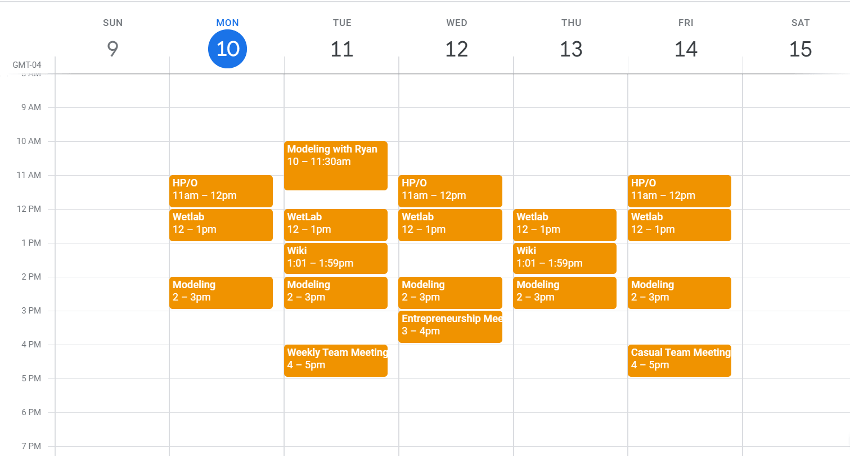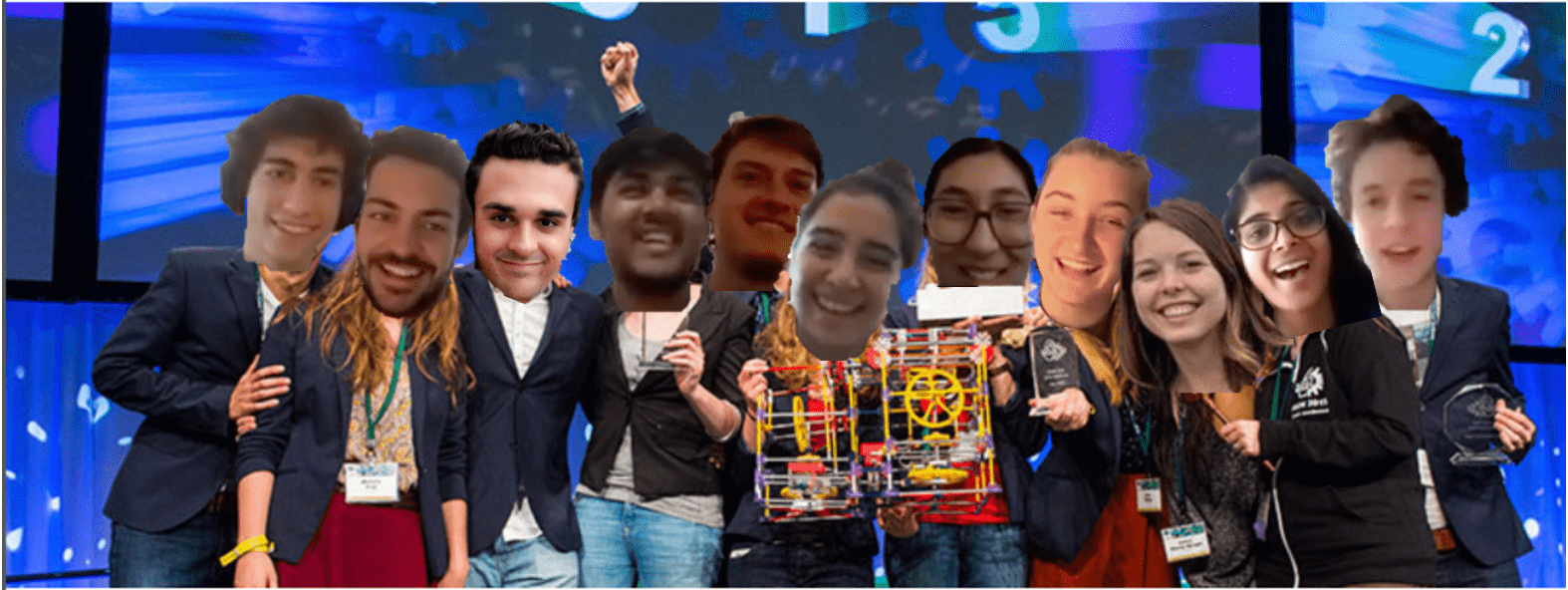This year’s team is the 14th Virginia iGEM team to compete in the INTERNATIONAL GENETICALLY ENGINEERED MACHINE competition, the Giant Jamboree, following a legacy of successful teams and their inventive synthetic biology solutions. Under the guidance of our advisors, PROFESSOR PAPIN and PROFESSOR KOZMINSKI (Biomedical Engineering and Biology Departments, respectively), Virginia iGEM has consistently received recognition at the competition, as well as seeding biotech startups AGROSPHERES INC and Transfoam LLC. Along with a strong reputation to live up to, the 2020 Team has been incredibly resilient in the face of the COVID-19 pandemic.
Virginia iGEM During the Pandemic
The Problem
Eleven students from the Engineering School and the College of Arts and Sciences were selected out of a competitive pool to represent UVA in the 2020 competition. We joined the team with hopes of spending a summer in Charlottesville, pursuing our own SYNTHETIC BIOLOGY project from start to finish, and gaining hands-on lab experience. To some extent those hopes are still being fulfilled, but not in the ways that we expected. We’ve had to adapt nearly every facet of our project to be feasible from our own homes, and spent countless hours staring at each other’s digital floating heads. We’ve also been restricted access from our summer lab space, and struggling with grant approval for our lab work and stipends -- so the question you’re probably still wondering is… how? How does a team conduct research from home, or even function cohesively?
Let’s start by looking at what problems we’re facing. The iGEM competition requires “deliverables,” or tangible components to be judged. Because of the nature of the competition, teams usually split into multiple committees to conquer the deliverables; for examples, our team consists of Wet Lab, Modeling, Wiki, Human Practices (HP), and Entrepreneurship, each of which contribute unique deliverables to the overarching project goal.
Adaptations
Modeling, Wiki, and HP were fairly straightforward to adapt; most of their work is already done online -- coding for mathematical models, designing a website, consulting with experts -- so those committees had a smooth transition. Wet Lab, on the other hand, is meant to be a full, hands-on learning experience. This committee is necessary to develop a full proof-of-concept, but because we don’t have summer access to a lab, the responsibility of Wet Lab has largely shifted back to basics: experimental design. We have been meticulously designing a hypothetical lab plan, from designing specific DNA sequences to commercially synthesize, to how we’ll cut and paste the final parts together, to checking the resulting sequences for accuracy. If we are lucky enough to get lab time this Fall, we are beyond prepared to hit the ground running.
Entrepreneurship has also been an interesting case. This committee was spontaneously formed partway through our summer research in response to a commonly held desire to turn our research into a startup. With some extra time on our hands, we were focused on protecting our intellectual property, or IP, and exploring the PATENTABILITY of our idea. The Entrepreneurship committee consulted various IP experts in the C’VILLE COMMUNITY over Zoom, sought to understand prevention of PUBLIC DISCLOSURES, and is currently working to file our provisional patent application.
How We Overcame
Meeting Structure
You might now be asking yourself, “that sounds like a lot to coordinate online with 11 people.” Truthfully, yes. Yes it is. We somewhat anticipated this, so one of our first actions as an online team was to recreate our opportunities for lab interactions on Zoom -- each committee would meet for an hour a day, and the team would meet once a week. Everyone is part of 2-3 committees, so they’re committed to approximately 8-15 hours of Zoom per week, plus individual work they contribute outside of those meetings. The schedule (above) has shifted around as committees needed to meet more or less often, but essentially we divide and conquer. Cross-committee communication was just as important as compartmentalization, so we added a second weekly team meeting to keep each other up-to-date. As an added bonus, we often meet outside of the designated times to have “work-jams” where one person plays our team Spotify playlist over Zoom while everyone does their individual work; it’s been a great way to foster collaboration and be available to one another. We are bummed out about missing our sunset hikes and white water rafting, but we make up for it by having game nights and movie nights to bring us closer as a team.
Project Management and Design: Tools and Resources

Screenshot depicting our team meeting schedule on a normal work-week
As for the resources we used to keep track of teamwork and project organization, we found a number of great websites and collaborative programs to use as we progressed. For example, we have a ZOOM ROOM that we programmed so anyone can join at any time-- committees schedule times in the “Virginia Lab Room” as if they are meeting in a physical lab space, which we coordinate with our shared Google Calendar (above) while creating and planning documents, presentations, spreadsheets, etc. in our Google Drive repository.
The team also uses TRELLO, a project management tool that essentially functions as a big, digital billboard where we organize our big tasks, hurdles, and successes for the whole team to account for.
BENCHLING is another indispensable resource that Wet Lab uses. It contains a group lab notebook, functions to collaboratively design and assemble all the parts we need so that anyone can edit/view them, and is capable of running a number of hypothetical lab procedures like digests and assemblies so we know what our results should look like. So far, we have designed dozens sequences and ran countless digests and assemblies.
LUCIDCHART functions as our main workflow site, where Wet Lab and Modeling lay out what steps must be taken to create our deliverables. Each chart is essentially one giant blueprint detailing our experiment step by step.
REPL.IT is Wiki’s tool for collaborative coding. Members of the committee can edit the html code for the website simultaneously, check to make sure it runs perfectly, and then transfer the code for finished pages over to the official iGEM Wiki page.
As for modeling, MATLAB, COBRA, the RBS CALCULATOR, and METACYC are a few of the many indispensable resources we have used to find, generate, and analyze relevant data to answer some of Wet Lab’s most pressing questions, and to broaden the scope of our project in silico.
Achievements
After all of the effort poured into organization and finding online resources, the results are speaking for themselves. As of writing this, we are 3 months into our project, and have already produced meaningful deliverables for the upcoming GIANT JAMBOREE COMPETITION. The Human Practices committee has written a 6-page Code of Ethical Conduct that lays out how our team strives to ethically practice research, drawing on numerous guiding resources and expertise from UVA Professor Mimi Riley and Dr. Lois Shepherd. The Modeling committee has produced a few complex models of our E. coli system using Escher and Matlab, and a promoter optimization model that informed which promoters the Wet Lab team would use. They are also in the process of creating a model of drug production to evaluate how competitive our product would be on the market. Wet Lab is in conversation with Dr. Martin Warren’s lab in the UK regarding a specific paper of his that heavily informs our project, and has also conducted interviews with some of the top scientists in our field of research, notably Dr. Cheryl Kerfeld of UC Berkeley. The Entrepreneurship team is working to submit our provisional patent, which should be approved within the next couple of weeks.
Closing Thoughts
Honestly, this isn’t the experience most of us were expecting, but it has been invaluable nonetheless. The main takeaways have been learning how to communicate as a team, how to overcome unforeseen setbacks - both due to Covid and to the complexity of any virtual research project - and how to use technology to our advantage on every front. Luckily, we’ve got some limited lab space available to us during the Fall semester, but the lack of funding is still our biggest unresolved hurdle. Despite the many setbacks, our experience has been full of silver linings. For example, we get to bring our pets to “lab,” and we wear whatever we want - whether that’s open toed shoes, sunglasses, multiple shirts, or electromagnetic brain stimulation devices. We’ve had months of time simply for planning and designing the absolute best version of our synbio project, and when we finally get into a lab we’ll be extremely well prepared. We’ve even had the chance to connect with experts at UVA Law, UVA BME and even experts worldwide, which was only made possible by the culture of virtual learning.
In reading this, you’ve gotten a glimpse into the online world which we suddenly adapted to. This article only begins to cover the amount of work that has gone into our project, and any iGEM member would tell you that the blue-light-induced headaches and hours spent pounding our keyboards have been draining. But it has definitely been worth it.

- The 2020 Virginia iGEM